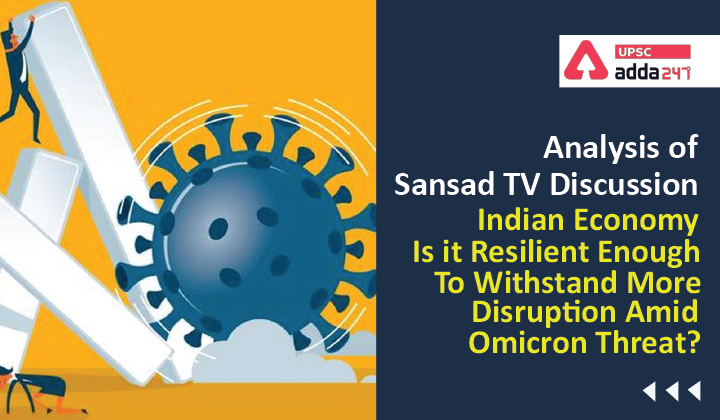Table of Contents
Context
- By the end of the financial year 2021-22, India’s GDP is expected to come back to the pre-Covid level. Given the severity of the second Covid wave, that is a matter of relief.
- Though the Indian economy continues to forge ahead, emerging out of shackles of the pandemic, the rise of the Omicron variant has emerged as the biggest risk factor, said the state of the economy report released with the Reserve Bank of India (RBI).
State of the Economy
- The global economy remains hostage to heightened uncertainty, with Omicron sparking fresh containment measures.
- The Indian economy bounced back strongly in Q2:2021-22, with GDP surpassing its pre-pandemic levels, and inflation broadly aligning with the target.
- In November, the retail inflation came at 4.91 per cent, but the wholesale price index (WPI), which is no longer targets, came at a 12 year high of 14.23 per cent.
- A host of incoming high-frequency indicators are looking upbeat and consumer confidence is gradually returning.
- Aggregate demand conditions point to sustained recovery, albeit, with some signs of sequential moderation.
- On the supply front, the farm sector situation remains strong with the impressive progress of Rabi sowing, while the manufacturing and services record strong improvement on strengthening demand conditions and surge in new business.
What is K-shaped recovery?
- Critics have named the recent recovery in the Indian economy, K-shaped recovery.
- The recovery has altered the shape and fabric of the Indian economy. In technical jargon, it is called a K-shaped recovery.
- In simple terms, it means that while some sectors/sections of the economy have registered a very fast recovery, many are still struggling.
- The entities that have done well are firms that were already in the formal sector and had the financial wherewithal to survive the repeated lockdowns and disruptions.
- In fact, many big firms in the formal economy have actually increased their market share during the Covid-19 pandemic and this has come at the cost of smaller, weaker firms that were mostly in the informal sector.
What did Finance Ministry’s Recent Monthly Economic Review Say?
- According to Finance Ministry, the new Omicron variant of Covid-19 may pose “a fresh risk” to the ongoing global recovery, but its impact would be “less severe” for India due to the increasing pace of vaccination in the country
- Ministry also expressed confidence in the robust recovery of the domestic economy in the third and the fourth quarters of the financial year that ends in March.
- India’s economic recovery is expected to gain further strength in the remaining two quarters of the current financial year, as evident from 19 among 22 high-frequency indicators (HFIs) in September, October and November crossing their pre-pandemic levels in the corresponding months of 2019.
- India’s economic recovery is expected to gain further strength in the remaining quarters of the financial year on the back of upbeat market sentiments, rapid vaccination coverage, strong external demand and continuous policy support by the Government and RBI (Reserve Bank of India).
- However, the new Omicron variant of Covid-19 poses a challenge to sustained recovery, and Covid-19 appropriate behaviour is warranted.
Factors that are likely to play a crucial role in how the economy shapes up in 2022
- OMICRON: If Omicron and other variants pose threat to life or economic disruption then the economy may face a huge backlash once again.
- Union Budget: In times of such upheaval, the Budget is more than just an accounting exercise. The government would be expected to lay out its plan to tackle high unemployment, high inflation, widening inequalities and rising poverty levels by recognising K-shaped recovery at all in its pronouncements.
- Elections: The repeal of the three contentious farm laws was another example of how policymaking can be impacted by electoral pressures. In that regard, 2022 is a critical year.
- NPAs: Before Covid disrupted India’s economy, high levels of non-performing assets (NPAs) were one of the biggest stumbling blocks. During Covid, mandatory asset quality reviews have been suspended. But when they are re-started in 2022, it is anybody’s guess how high they may jump.
- External Factors: Several key central banks, especially the US Fed, have started tightening their monetary policy in light of the high inflation in the developed countries. This, in turn, will force India’s RBI to raise interest rates as well. To a great extent monetary tightening has already happened in India. For Indians, the silver lining is that as monetary tightening happens in the West, crude oil prices may simmer down.
Way Forward
- The economy is better prepared to work, even with Covid, with rapidly growing vaccination coverage and lessons learnt from the second wave in containing the contagion.
- The government should be cautious about the Omicron variant, with rapid vaccination and strong Covid-19 protocols, this way it will confidently sustain growth momentum.
- This year’s GDP (gross domestic product) numbers would be very encouraging if we can save the economy from the side effects of Omnicom and we’d be the fastest growing economy in the world.
Conclusion
If 2020 was the year when Covid hit India and 2021 was the year when India’s economy recovered from that shock, then 2022 should be the year that will provide a snapshot of the economy as it is coming out of the Covid impact. It can then be compared with how the economy was in 2019 to figure out what has changed and what needs policy attention. But the timelines for these steps are now mired in uncertainty, influenced by the Omicron variant and the evolving growth-inflation dynamics. Considering that the economic recovery remains uneven, the MPC and government should remain cautious, remain data-dependent, and calibrate its next steps carefully.



 TSPSC Group 1 Question Paper 2024, Downl...
TSPSC Group 1 Question Paper 2024, Downl...
 TSPSC Group 1 Answer key 2024 Out, Downl...
TSPSC Group 1 Answer key 2024 Out, Downl...
 UPSC Prelims 2024 Question Paper, Downlo...
UPSC Prelims 2024 Question Paper, Downlo...





